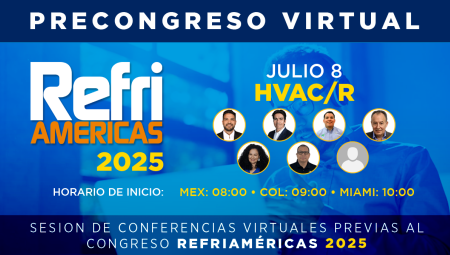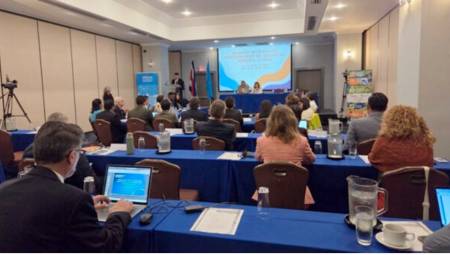By: Julián Arcila
 For many experts, the European CVAC/R industry is quite advanced and is the one that marks the path of development and evolution in the world. However, it is a reality that globally there are several general trends and that, as far as air conditioning is concerned, they are moving towards energy efficiency, environmental protection and the reuse of natural resources.
For many experts, the European CVAC/R industry is quite advanced and is the one that marks the path of development and evolution in the world. However, it is a reality that globally there are several general trends and that, as far as air conditioning is concerned, they are moving towards energy efficiency, environmental protection and the reuse of natural resources.
In this sense, one of the main components of the last version of Climatización, an exhibition held in Madrid at the end of last February, was the Galería de la Innovación Climatización 2009, in which a significant number of companies and solutions for the purposes previously mendionados were presented.
ACR LATINOAMÉRICA chose five of these companies/solutions to review them as truly innovative products.
Efficient and low-noise heating
The first product to review is the water-water heat pump from Climate Master, a hydronic solution that can be used for underfloor heating, ice/snow melting, residential water heating, among others. According to the manufacturer, it offers advanced features, quiet operation and flexibility in terms of allowed applications.
The company's THW series of water-water heat pumps features an innovative double-insulated compressor mounting system, which ultimately ensures that this range is among the quietest on the market. This is achieved thanks to a system that isolates the compressor by placing it on rubber eyelets, in addition to other anti-vibration mechanisms.
Hydronic systems, mainly those that use underfloor heating, offer lower operating costs than those of forced air, said sources from the manufacturer. According to a statement provided by Climate Master, "circulating air through the pipeline requires more watts than circulating water through the pipe. For example, a typical gas boiler for residential use of 80% efficiency, with an output capacity of 80 thousand Btuh (23.4 Kw) uses an 850 watt motor for the fan. For every watt used to power the fan, 94 Btuh (28 watts) of heat is released through the forced air duct. If a boiler or heat pump is used to generate heat, but the heat is released through a radiant floor system, the pumping power would be around 300-400 watts, or 40-50% of the watts of the air release system, resulting in about 230 Btuh (67 watts) of heat per watt of pumping power."
Defrosting is now smart
According to the company Airlan, heat pumps usually have several problems related to the loss of heat capacity and decreased performance. And for this reason the company developed an intelligent defrosting system, which is designed to increase energy efficiency.
This innovation is initially applied to the ANL machine, which is an air/water cooler that works with R-410. According to Iker Garay, an engineer at the manufacturing company, the advantage of this system is in the way it performs defrosting. "Most heat pumps usually do defrosting by cycle reversal, that is, when the machine detects that there is the presence of ice. What drawbacks does this process bring? It is basically reflected in a loss of system performance. The advantages of this system is that it does not penalize performance and that the increase in comfort and efficiency is significant compared to a traditional system."
Fashionable air conditioning
For several years now, the exhibitions of air conditioning equipment have seen how air conditioning systems, more precisely those of the split and minisplit type, are coming into line with the new trends of interior design, exhibiting housings with futuristic appearances and quite aesthetic.
One of these examples is Samsung, a company that during Climatización 2009 was presenting its most recent range of equipment with the aforementioned characteristics. In this regard, ACR LATINOAMÉRICA interviewed María Alcázar, sales manager for Spain of the air conditioning division.
According to the executive, what made this product was considered within the innovation showcase is that in addition to the design, which allows the front panels to be exchanged, the solution is a good alternative if what is sought is energy efficiency. They also have an air purification system that meets the highest standards on the market. It is worth saying that this is a solution designed basically for the residential market.
"The system has a filter that we call MPI that is an ion-generating technology and then another filter called DNA that what it carries is the structure of the DNA, which favors that the particles are caught easier and therefore you have a cleaner air," said María.
Aesthetically speaking, this unit is characterized because it is quite compact and suitable to be located in any space within the house.
An important fact mentioned by María is that currently the Spanish residential market offers an important number of opportunities for the air conditioning segment, despite the hard times that the construction industry is experiencing in global markets. "The penetration of air conditioning in Spain is 30%, so there are many properties that do not have this system. In homes already built, the best alternative is the use of residential systems one by one," said Alcázar.
Complement for the solar collector
Another application that was observed during the last showcase of innovation in Climatización 09 was the IPEsol kit, which is actually a complement to the hemispherical plastic collector that this company launched a couple of years ago in the same exhibition and that was also included in the innovation showcase. One of the particularities of this solution is that it is easy to apply in Latin America and with a relatively low cost, which suggests that it could be an alternative for the generation of heating and domestic hot water in Latin countries.
Antonio Nieto is the manager of IPEsol and was the one who spoke about the solution. According to him, the advantage offered by this system is that it allows the instantaneous generation of hot water without the need for accumulation, and can be applied especially in those areas of the planet where there are a good number of hours of sunshine and a high temperature.
"It's a very conducive solution for Latin America," he said. He added that "in fact we are thinking that this would be one of the main areas of action and we have even thought about manufacturing the solution there."
Another special feature is that it can be installed in the house both before and after construction, in addition to the fact that it is quite easy to do so. "The mounting system is very simple. No tools are required and it can be practically a 'do it yourself,'" Nieto explained.
In terms of costs, a standard sanitary water solution is around US$4,000, while IPEsol's is around US$400.
Geothermal energy, another great heating alternative
In Spain and in general in those regions of the world where the use of heating systems is required, electricity costs are one of the biggest concerns. This was really the distinctive element of Climatización 09, an industry completely focused on how to find energy-efficient solutions and increasingly cleaner production, ostensibly reducing CO2 emissions.
The last solution that will be reviewed within the visit to Climatización 2009 is the Ferroli geothermal heat pump.
In the opinion of the company's executives, the solution has two differentiating elements compared to its market peers. On the one hand, there is control, which is a fundamental element in any air conditioning system. "It is a powerful control that allows to integrate several generation systems for the air conditioning of a house. We can be working with solar energy, with a gas boiler and with the heat pump. The control will decide at all times, based on the demand that the house has, with which of these elements it will work, "said the representatives of the company.
The other differentiating element is that the entire part of the refrigeration circuit enters a separable drawer, so that when maintenance has to be done, the machine does not have to intervene, but the refrigeration circuit and the rest of the equipment are hydraulically isolated.
Traditionally, these types of products were developed for cold weather for their operating stability. These obtain heat from the depths of the earth through a probe. In these solutions, the sounding from 15 meters the temperature is the same and then no matter how cold the weather is, you always have the same performance from the machine.
"The advantage that this type of products have, for regions such as Spain and in general Mediterranean, is that if you can use it in a cold cycle you increase the seasonal yield and also cause the self-recovery of the land: in winter you give heat relatively cooling the land and in summer you produce cold by heating it relatively", explained the representatives of Ferroli.













